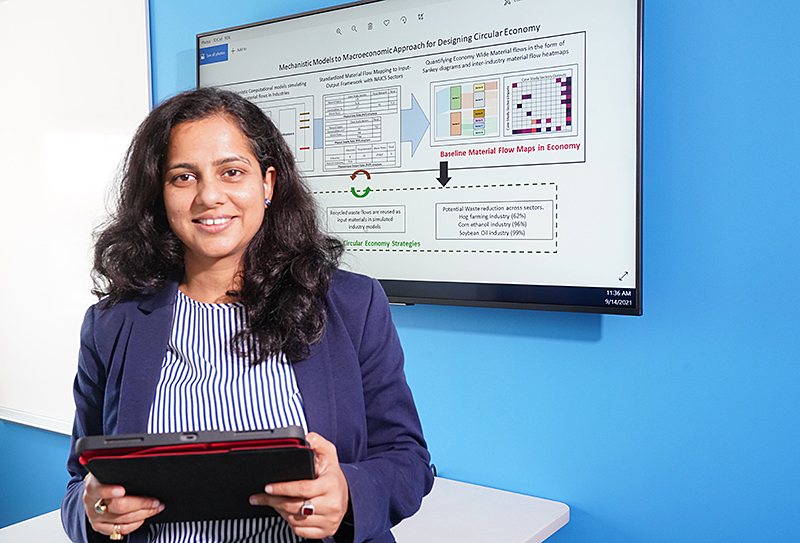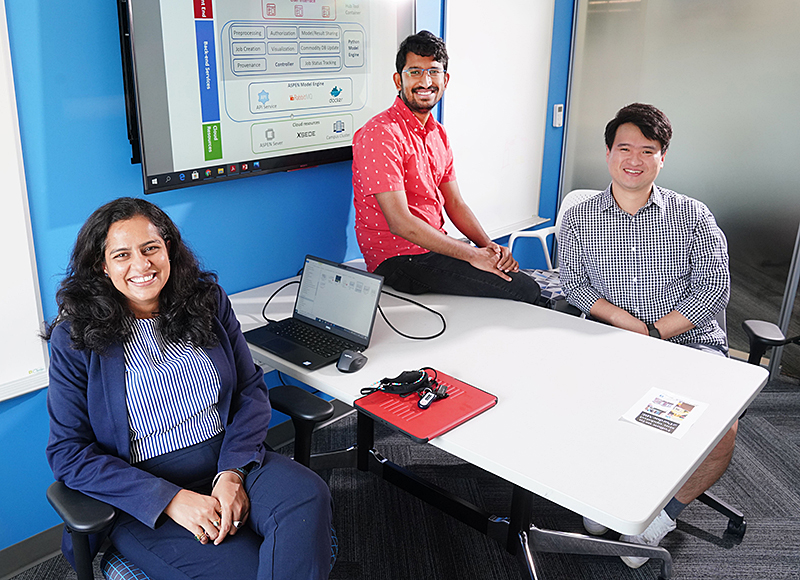September 27, 2021
New tool finds the best opportunities to reduce, reuse and recycle across industrial sectors
Fast, automated modeling of the physical economy gives users a test-run of steps to sustainability
WEST LAFAYETTE, Ind. — A new tool finds hidden connections across industrial sectors and identifies opportunities to reduce waste and lower carbon emissions by mapping the physical economy for a region.
“The climate and the economy are too important for us to make mistakes,” said Shweta Singh, the interdisciplinary scientist at Purdue University who developed the tool. “This tool provides a big-picture view and allows policymakers and industry to plug in a potential change and see the results. Those involved can virtually test different options before making a decision.”
 Shweta Singh (Photo by Tom Campbell)
Download image
Shweta Singh (Photo by Tom Campbell)
Download image
Past zero-waste and low-carbon efforts focused on one portion of industrial flow, for example, reducing energy use in a single production process. However, a view of the whole system is needed to make the best choices and most effective investments in emerging technology for overall improvement, she said.
“The approach is like the human genome project, but for the physical economy – mapping the relationship between industry and the environment,” said Singh, who holds appointments as an assistant professor of agricultural and biological engineering in the College of Agriculture and environmental and ecological engineering in the College of Engineering. “It allows us to find and understand connections within the whole system. We needed the human genome project – the complete map - to begin to identify the genes key to disease or health, and we need a complete map of the physical economy to identify what changes are key to achieving sustainability.”
 From left are Shweta Singh, assistant professor of agricultural and biological engineering at Purdue University, and graduate students Venkata Sai Gargeya Vunnava and Jaewoo Shin. (Photo by Tom Campbell)
Download image
From left are Shweta Singh, assistant professor of agricultural and biological engineering at Purdue University, and graduate students Venkata Sai Gargeya Vunnava and Jaewoo Shin. (Photo by Tom Campbell)
Download image
The theory behind the model is detailed in a paper in the journal Energy & Environmental Science of The Royal Society of Chemistry. A paper focused on the cloud platform tool will be published in the Journal of Industrial Ecology.
The tool uses physical principles and mechanistic models from physics, engineering and biological sciences to automate mapping of the physical economy, and it is much faster than the standard methods, Singh said.
“With this modeling tool, we can do in one day what would have taken 100 days,” she said. “The existing mapping methods were tedious and time consuming. By looking at each economic sector as a process - taking resources through physical changes to create a product – we can use existing mechanistic models to map a multiscale view of the physical economy. With that in place we can make changes and see the cascade of events from the process to sector to whole economy.”
Singh used the tool to map the physical economy of Illinois for 10 agro-based sectors from farming to downstream processing of products. The model found connections and highlighted opportunities for large-scale recycling to reduce waste. The results showed that the adoption of technologies for industrial wastewater and hog manure recycling would have the highest impact by reducing more than 62% of hog waste outputs, 96% of dry corn milling waste, and 99% of soybean hull waste.
“We also found indirect connections, for example recycling hog farm waste led to reduced emissions down the line in manufacturing,” Singh said. “In the supply chain, experts talk about first, second- and third-order impacts. Third-order impacts may not be obvious, but they can really have an impact. Here it becomes transparent, and we can identify that third-order impact very quickly.”
Singh credits a diverse academic background in sparking the idea for the model.
“I always had an interest in various disciplines,” she said. “My friends joked I had taken a class in every building on campus. I actually began my studies in chemical engineering, which takes a very close look at the flow of a chemical reaction and the byproducts created. Then, while studying sustainability assessment for industrial systems, I broadened my scope to macroeconomic framework. It led me to wonder why there wasn’t more communication and crossover between the disciplines. In this model, I try to bring all of these things together, connecting process engineering with economic modeling.”
Singh also credits the interdisciplinary background of Venkata Sai Gargeya Vunnava, the graduate student who collaborated on the project.
“Thinking about the challenge without being mentally stuck in a single academic discipline led to this innovation,” Singh said. “We must be open to learning anything from anywhere.”
Singh disclosed the modeling tool to the Purdue Research Foundation Office of Technology Commercialization, which has applied for patent protection on the intellectual property. The Office of Technology Commercialization is currently looking for partners to help commercialize this technology.
The National Science Foundation (CBET-1805741) funded Singh’s work.
A U.S. patent is pending on the cloud platform implementing the methodology for automation, with potential for commercialization as technology.
Writer: Elizabeth K. Gardner; 765-441-2024; ekgardner@purdue.edu
Source: Shweta Singh; 765-476-3625, singh294@purdue.edu
ABSTRACT
Integrated mechanistic engineering models and macroeconomic input-output approach to model physical economy for evaluating the impact of transition to a circular economy
Venkata Sai Gargeya Vunnava and Shweta Singh
Sustainable transition to low carbon and zero waste economy requires a macroscopic evaluation of opportunities and impact of adopting emerging technologies in a region. However, a full assessment of current physical flow and waste is a tedious task, thus leading to a lack of comprehensive assessment before scale up and adoption of emerging technologies. Utilizing the mechanistic models developed for engineering and biological systems with the macroeconomic framework of Input–Output models, we propose a novel integrated approach to map the physical economy that automates the process of mapping industrial flows and wastes in a region. The approach is demonstrated by mapping the agro-based physical economy of the state of Illinois, USA by using mechanistic models for 10 agro-based sectors, which have a high impact on waste generation. Each model mechanistically simulates the material transformation processes in the economic sector and provides the necessary material flow information for physical economy mapping. The model for physical economy developed in the form of a Physical Input–Output Table (PIOT) captures the interindustry physical interactions in the region and waste flows, thus providing insight into the opportunities to implement circular economy strategies i.e., adoption of recycling technologies on a large scale. In Illinois, adoption of technologies for industrial wastewater and hog manure recycling will have the highest impact by reducing >62% of hog industry waste outputs, >99% of soybean hull waste, and >96% of dry corn milling (corn ethanol production) waste reduction. A small percentage reduction in nitrogen fertilizer manufacturing waste was also observed. The physical economy model revealed that the urea sector had the highest material use of 5.52 × 108 tons and green bean farming with the lowest material use of 1.30 × 105 tons for the year modeled (2018). The mechanistic modeling also allowed elemental flows across the physical economy to be captured, with the urea sector using 8.25 × 107 tons of elemental carbon per operation-year (highest) and green bean farming using 3.90 × 104 tons of elemental carbon per operation-year (least). The approach proposed here establishes a connection between engineering and physical economy modeling community for standardizing the mapping of physical economy that can provide insights for successfully transitioning to a low carbon and zero waste circular economy.
Agricultural Communications: 765-494-8415;
Maureen Manier, Department Head, mmanier@purdue.edu

